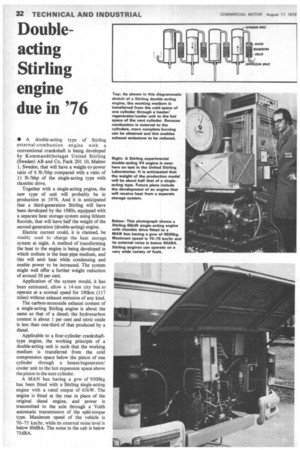Double
Page 34

If you've noticed an error in this article please click here to report it so we can fix it.
acting Stirling engine due in '76
• A double-acting type of Stirling external-combustion engine with a conventional crankshaft is being developed by Kommanditbolaget United Stirling (Sweden) AB and Co, Fack 201 10, Malmo 1, Sweden, that will have a weight-to-power ratio of 6 lb /bhp compared with a ratio of 11 lb /bhp of the single-acting type with rhombic drive.
Together with a single-acting engine, the new type of unit will probably be in production in 1976. And it is anticipated that a third-generation Stirling will have been developed by the 1980s, equipped with a separate heat storage system using lithium fluoride, that will have half the weight of the second-generation (double-acting) engine.
Electric current could, it is claimed, be readily used to charge the heat storage system at night. A method of transforming the heat to the engine is being developed in which sodium is the heat-pipe medium, and this will emit heat while condensing and enable power to be increased. The system might well offer a further weight reduction of around 50 per cent.
Application of the system would, it has been estimated, allow a 14-ton city bus to operate at a normal speed for 190km (117 miles) without exhaust emission of any kind.
The carbon-monoxide exhaust content of a single-acting Stirling engine is about the same as that of a diesel; the hydrocarbon content is about 1 per cent and nitric oxide is less than one-third of that produced by a diesel.
Applicable to a four-cylinder crankshafttype engine, the working principle of a double-acting unit is such that the working medium is transferred from the cold compression space below the piston of one cylinder through a heater/regenerator/ cooler unit to the hot expansion space above the piston in the next cylinder.
A MAN bus having a gvw of 9500kg has been fitted with a Stirling single-acting engine with a rated output of 65kW. The engine is fitted at the rear in place of the original diesel engine, and power is transmitted to the axle through a Voith automatic transmission of the split-torque type. Maximum speed of the vehicle is 70-75 km/hr, while its external noise level is below 80dBA. The noise in the cab is below 75dBA.




























































































